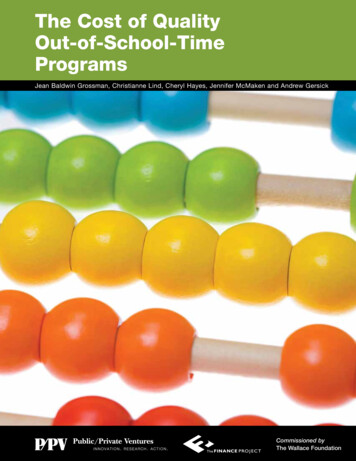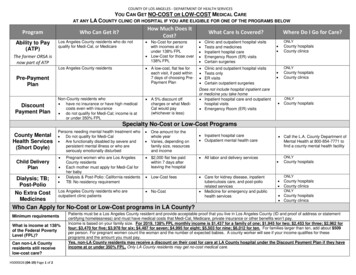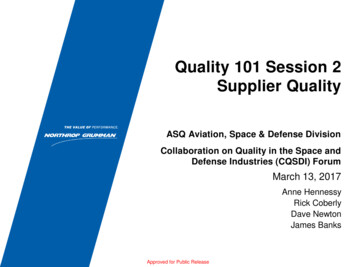
Transcription
The Cost of QualityOut-of-School-TimeProgramsJean Baldwin Grossman, Christianne Lind, Cheryl Hayes, Jennifer McMaken and Andrew GersickCommissioned byThe Wallace Foundation
The Cost of QualityOut-of-School-TimeProgramsJean Baldwin GrossmanChristianne LindCheryl HayesJennifer McMakenAndrew GersickPublic/Private Ventures’Out-of-School-TimeCost Study TeamThe Finance Project’sOut-of-School-TimeCost Study TeamMargo CampbellAndrew GersickJean Baldwin GrossmanJennifer McMakenSoumya BhatSharon DeichCheryl HayesChristianne LindNanette RelaveNichole StewartCommissioned byThe Wallace Foundation
The Cost of Quality Out-of-School-Time ProgramsPublic/Private Ventures is a national leader in creating andstrengthening programs that improve lives in low-incomecommunities. We do this in three ways:The Finance ProjectHelping leaders finance and sustain initiatives that lead to betterfutures for children, families and communities.innovationThe Finance Project is an independent nonprofit research,consulting, technical assistance, and training firm for publicand private sector leaders nationwide. We specialize in helping leaders plan and implement financing and sustainabilitystrategies for initiatives that benefit children, families andcommunities. Through a broad array of products, tools andservices, we help leaders make smart investment decisions,develop sound financing strategies, and build solid partnerships. To learn more, visit www.financeproject.org.We work with leaders in the field to identify promisingexisting programs or develop new ones.researchWe rigorously evaluate these programs to determine what iseffective and what is not.actionWe reproduce model programs in new locations, providetechnical assistance where needed and inform policymakersand practitioners about what works.P/PV is a 501(c)(3) nonprofit, nonpartisan organization withoffices in Philadelphia, New York City and Oakland. Formore information, please visit www.ppv.org.The Wallace FoundationThe Wallace Foundation seeks to support and share effectiveideas and practices that expand learning and enrichmentopportunities for all people. Its three current objectives are:Board of DirectorsResearch AdvisoryCommittee Strengthen education leadership to improve studentachievement,Matthew McGuire, ChairVice PresidentAriel Capital Management, Inc.Frederick A. DaviePresidentPublic/Private VenturesYvonne ChanPrincipalVaughn Learning CenterThe Honorable RenéeCardwell HughesJudge, Court of Common PleasThe First Judicial District,Philadelphia, PAChristine L. James-BrownPresident and CEOChild WelfareLeague of AmericaRobert J. LaLondeProfessorThe University of ChicagoJohn A. Mayer, Jr.Retired, Chief Financial OfficerJ. P. Morgan & Co.Anne Hodges MorganConsultant to FoundationsSiobhan NicolauPresidentHispanic PolicyDevelopment ProjectMarion PinesSenior FellowInstitute for Policy StudiesJohns Hopkins UniversityClayton S. RoseSenior LecturerHarvard Business SchoolCay StrattonSpecial AdvisorU.K. Commission forEmployment and SkillsSudhir VenkateshAssociate ProfessorColumbia UniversityWilliam Julius WilsonLewis P. and Linda L.Geyser University ProfessorHarvard UniversityJacquelynne S. Eccles, ChairUniversity of MichiganRobert GrangerWilliam T. Grant FoundationRobinson HollisterSwarthmore CollegeReed LarsonUniversity of IllinoisJean E. RhodesUniversity of Massachusetts,BostonThomas WeisnerUCLA Improve after-school learning opportunities and Build appreciation and demand for the arts.For more information and research on these and otherrelated topics, please visit Wallace’s Knowledge Center atwww.wallacefoundation.org.To fulfill its mission, The Wallace Foundation often commissions research and supports the creation of various publications. In all cases, the findings and recommendations ofindividual reports are solely those of their authors.
The Cost of Quality Out-of-School-Time ProgramsAcknowledgmentsWe are indebted to many individuals who helpedmake this study possible. First and foremost, wewould like to thank the out-of-school-time (OST)program leaders and key informants interviewedand surveyed for this study in Boston, Charlotte,Chicago, Denver, New York City and Seattle.Although we cannot acknowledge them by namefor confidentiality reasons, we are extremelygrateful for their willingness to share detailed costinformation with us.During the past two years, many staff from Public/Private Ventures and The Finance Project have contributed to the study. Sharon Deich, who was at TheFinance Project for much of the study, was criticalin the design and implementation of the research.In addition to the primary authors, Soumya Bhat,Margo Campbell, Andrea Esposito, Tina Kauh,Viany Orozco, Jennifer Pevar, Nanette Relave, NinaSalomon, Nichole Stewart and Femi Vance providedtremendous support with the design, data collection and analysis.A national advisory group of OST experts,including Nicole Gallant, Audrey Hutchinson,Priscilla Little, Harold Richman and Juanita Wade,provided invaluable feedback on the study design.This group was supplemented by Mary Ellen Caron,James Chesire, Joseph Cordes, Sheila Kirby, LauraLaCroix-Dalluhn, Brenda McLaughlin, JeanneMullgrav, Judy Nee, Stephen Pratt, Jane Quinn,Gregory Roberts, Hillary Salmons, Robert Stonehilland Michelle Yanche to review and comment onpreliminary findings. The group’s input has beeninvaluable to us in more thoroughly understandingthe findings and shaping the report’s presentation.The Wallace Foundation was instrumental inpioneering this large-scale cost study of a diverse setof high-quality OST programs, funding The FinanceProject and Public/Private Ventures to conduct theresearch and providing generous support along theway. Edward Pauly and Zakia Redd, in particular,worked closely with us, providing not only guidanceand advice but incentive resources when the datacollection turned out to be much more difficult thananyone had expected. They, along with colleaguesNancy Devine, Sheila Murphy, Dara Rose and ErinBrownfield, also provided useful feedback on thereport. Pam Mendels, a senior writer at Wallace,skillfully synthesized the comments of the Wallaceteam, including her own, to help improve the report.We are very grateful for their contributions.The authors would like to specially thank the production team. The numerical nature of the reportrequired extra care, but the many rounds of revisions (both before and during the production process) made it particularly challenging. The entireteam rose to the task. Penelope Malish unleashedher abundant creativity and skill to develop thereport’s design and didn’t flinch (much) at themany rounds of substantial change. Heidi Jacobstook extreme care in her proofreading of thereport. And, we could not have completed this project without the leadership of P/PV’s Chelsea Farleyand Laura Johnson who copyedited the reportmultiple times and oversaw its publication and dissemination. The report is substantively stronger fortheir efforts.
The Cost of Quality Out-of-School-Time ProgramsForeword: Understanding the Costs of Qualityby M. Christine DeVita, President, The Wallace FoundationEvery day, millions of children attend out-of-schooltime (OST) programs, and at the very least, parentsand children want to know that those programs aresafe and fun. But as state and federal funding forOST has risen in recent years, so have expectationsthat programs should provide more than just babysitting or a safe haven. Increasingly, OST programsare being asked to deliver meaningful homeworkhelp and other academic support, sports, artisticexperiences or other activities that help youngstersdevelop skills, form positive relationships withadults, and ease the transition to adulthood. Againstthis backdrop of rising expectations for delivering the kind of quality programs the public is nowdemanding—not to mention that young people canfreely choose to attend OST or not—there is a clearneed for better and more useful information aboutthe costs of providing quality programming, andhow OST programs of diverse sizes and missionscan calculate those costs for themselves.The Wallace Foundation has long supported arange of out-of-school opportunities, spurred by abelief that we as a society have a duty to surroundchildren with learning and enrichment both duringand beyond the school day. Currently, we are helping to develop and test what we call “coordinatedapproaches,” citywide initiatives that bring togethermany different players essential to OST—schools,parks departments, community groups and others—to improve out-of-school time. Our work, nowgoing on in Boston, Chicago, New York, Providenceand Washington, DC, has taught us that building effective, citywide OST programming requiressix key elements, including: strong, committedleadership; multiyear planning to set goals, identifyneeded resources and hold key players accountable;a public or private coordinating entity to keep thoseplans on track and help build citywide support forOST; information systems capable of providingreliable data about participation trends and familyneeds; and an emphasis on expanded participationby young people.Perhaps most important, however, is the sixthelement we’ve identified: a commitment to quality. This is grounded in the idea, supported byresearch, that children are likeliest to realize OST’sbenefits when programs are good enough to keepkids coming back for more.The vital importance of quality is why we believethis report—and a companion online “costcalculator” available on Wallace’s website atwww.wallacefoundation.org/cost-of-quality—are so valuable. This new research provides thefield, for the first time, with hard evidence aboutthe costs that quality programs bear, filling a criticalinformation void and making it easier for many providers to plan for and reach the quality goal.Based on an unusually large and diverse sample—111 programs across six cities—the report demonstrates that the cost of quality varies depending ona range of factors including program goals, timesof operation and ages served. Programs for teenagers, for example, face different sets of likely costsfrom programs for elementary school students. Thesame is true for school-year as opposed to summerprograms, and programs that focus on academics asopposed to those offering multiple activities.This report is also one of the few to look at the fullcosts of quality programs, that is, the programs’cash outlays plus the value of the non-monetarycontributions, such as physical space or volunteertime, that so many OST programs rely on. Such inkind donations, in fact, make up on average nearlyone fifth of the total cost of quality OST programming, and in presenting that fact, this report givesplanners a keener understanding of the true costsof quality.Equally important, the research uncovers andexplains many complexities of OST costs. For example, it finds that expanding program size to includemore children can produce economies of scale—but only up to a point. The reason? After reachingcertain threshold enrollment numbers, detailed inthe report, quality programs must hire more corestaff, thereby ratcheting up costs.
The Cost of Quality Out-of-School-Time ProgramsBy providing such data, this report will, we hope,allow decision-makers to better assess differenttypes of programs, their requirements and theirassociated costs, and weigh them more thoughtfully against the needs of their communities. Wealso hope the report opens the door to a morefact-based conversation about the costs of qualityamong policymakers who set reimbursement ratesfor OST programs, funders who want to ensure thattheir support more accurately matches their aims,and OST providers who set priorities and create thebudgets for their programs.
The Cost of Quality Out-of-School-Time ProgramsContentsExecutive SummaryChapter I: Introductioni1Purpose of the Study. 2Research Questions. 3Methodology. 3Challenges of Developing Reliable Cost Estimates. 5How to Understand and Use the Different Cost Units. 6A Guide to the Report. 8Chapter II: Programs in the Study9Quality Attributes. 10Other Key Characteristics. 12Chapter III: Full Cost of Quality Out-of-School-Time ProgramsServing Elementary and Middle School Students15During the School Year. 16During the Summer. 19Cost Variations for Programs Serving Elementary and Middle School Students. 21Conclusion. 27Chapter IV: Full Cost of Quality Out-of-School-Time Programs Serving Teens29During the School Year. 30During the Summer. 33Cost Variations for Programs Serving Teens. 34Conclusion.
range of out-of-school opportunities, spurred by a belief that we as a society have a duty to surround children with learning and enrichment both during and beyond the school day. Currently, we are help- ing to develop and test what we call “coordinated approaches,” citywide initiatives that bring together many different players essential to OST—schools, parks departments, community .











